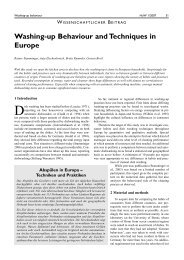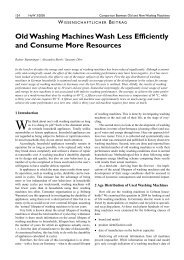Development of a novel mechatronic system for mechanical weed ...
Development of a novel mechatronic system for mechanical weed ...
Development of a novel mechatronic system for mechanical weed ...
You also want an ePaper? Increase the reach of your titles
YUMPU automatically turns print PDFs into web optimized ePapers that Google loves.
6 Summary<br />
Summary<br />
Neither a <strong>mechanical</strong> nor a physical <strong>system</strong> <strong>for</strong> effective intra-row <strong>weed</strong> control<br />
in row crops has been commercialised until today. Online detection <strong>of</strong> single<br />
plant position and plant/<strong>weed</strong> distinction are the bottlenecks <strong>of</strong> intra-row<br />
<strong>weed</strong>ing <strong>system</strong>s, but considering the rapidly growing research and<br />
development in this field, it is expected that appropriate <strong>system</strong>s will soon be<br />
available. In the meantime, construction and adjustment possibilities <strong>of</strong><br />
implements which take into account the role <strong>of</strong> soil properties and mechanics<br />
need to be optimised toward universal intra-row <strong>weed</strong>ing tools, which can be<br />
used in different plant spacing <strong>system</strong>s, different plant intra-row distances and<br />
growth stages.<br />
In this work development <strong>of</strong> a universal intra-row <strong>weed</strong>ing tool is presented from<br />
the idea to the first prototype.<br />
Accurate intra-row <strong>weed</strong> control requires either detection <strong>of</strong> the position <strong>of</strong> every<br />
crop plant or detection <strong>of</strong> every <strong>weed</strong>. In this work a simplified methodology and<br />
<strong>system</strong> <strong>for</strong> plant position detection based on the spectral characteristics <strong>of</strong> crop<br />
plants combined with the context in<strong>for</strong>mation <strong>of</strong> the planting pattern was<br />
developed and tested.<br />
The experimental results showed that the combination <strong>of</strong> the RGB sensor and<br />
laser sensor can be used <strong>for</strong> accurate detection <strong>of</strong> the plant centre position<br />
independently from illumination conditions. In the conducted experiments the<br />
maximum deviation <strong>of</strong> the estimated centre positions from the plant measured<br />
centre positions, detected by RGB sensor, was 31 mm, whereby 50% <strong>of</strong> the<br />
samples were inside the interval 0 to 5 mm and 90% <strong>of</strong> the samples were inside<br />
the interval 0 to 16,9 mm. For the laser sensor, the maximum deviation <strong>of</strong> the<br />
estimated centre positions from the plant measured centre positions was 25<br />
mm, whereby 50% <strong>of</strong> the samples were inside the interval 0 to 3 mm and 90%<br />
<strong>of</strong> the samples were inside the interval 0 to 6.9 mm.<br />
The main shortage <strong>of</strong> the presented <strong>system</strong> is that sensors require ad-hoc<br />
parameter adjustment be<strong>for</strong>e the measurement to provide good plant detection.<br />
121





